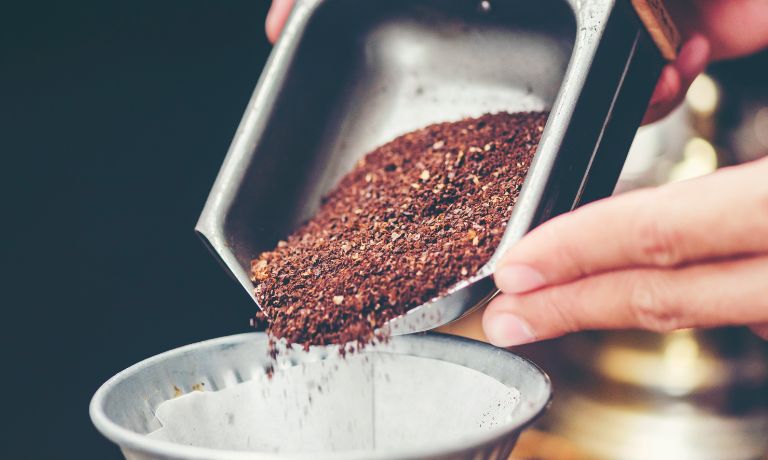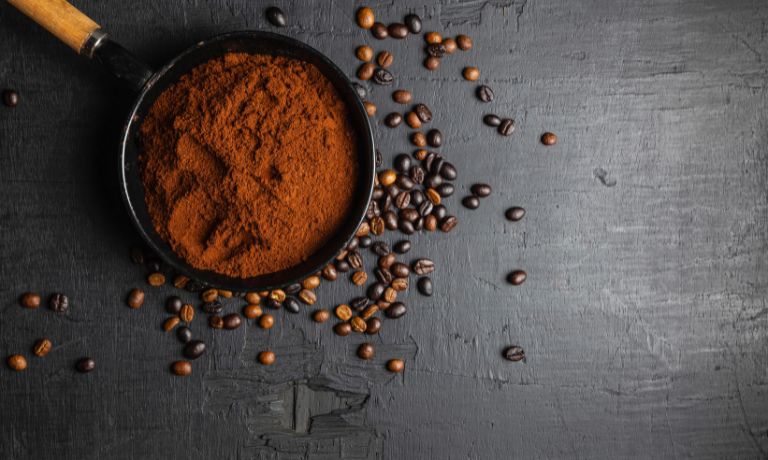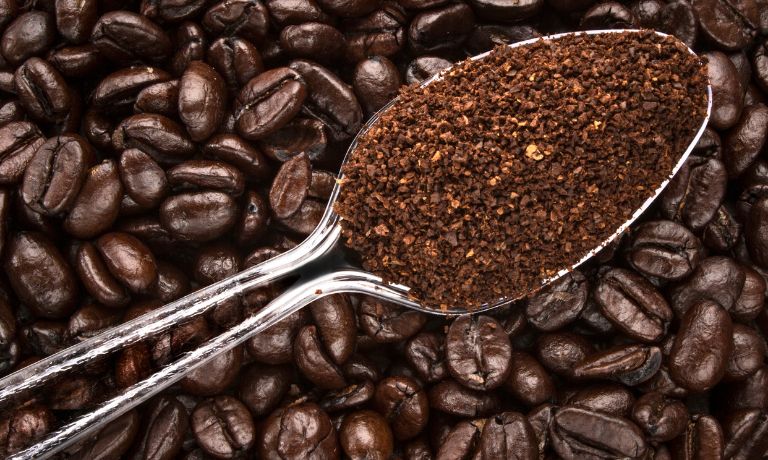If you love coffee, you know how important it is to get the right ratio of coffee grounds to water. But how much coffee grounds per cup should you use?
This blog post will explore the different types of coffee and give guidelines on how many coffee grounds to use for each type. We’ll also cover some tips and tricks to ensure you get the perfect cup of coffee every time. So, grab a mug and read on to learn more about how much coffee grounds per cup!
What Are Coffee Grounds?
For coffee lovers, the morning cup of java is a sacred ritual. But what about the coffee grounds left behind? These remnants of the brewing process often get tossed in the trash without a second thought.
However, coffee grounds are more than just a waste product – they can have a variety of uses. From fertilizing plants to deodorizing your fridge, there are plenty of reasons to hold onto your coffee grounds. So next time you brew a pot, think twice before you throw away those grounds – they might just come in handy!

Coffee ground
What Are The Benefits Of Using Coffee Grounds Instead Of Others?
Coffee grounds offer a unique and convenient alternative to traditional coffee beans. The most obvious benefit of using coffee grounds is that they are typically less expensive than other types of coffee commonly used in commercial coffee machines.
Additionally, coffee grounds can be used for many different purposes, not just for making coffee. For example, you can use coffee grounds to make scrubs or masks for beauty treatments, use them as fertilizer in the garden or mix them with other ingredients to make a delicious latte. Coffee grounds can also be used to deodorize smelly shoes, freshen up carpets, and even clean out greasy dishes.
Using coffee grounds instead of other types of coffee can also help reduce waste. Most traditional coffee beans can only be used once before they are discarded, whereas coffee grounds can be reused multiple times before they need to be thrown away. This makes using coffee grounds a great eco-friendly option and helps reduce the amount of waste in landfills or the environment.
Finally, coffee grounds often have a richer and more intense flavor than other coffee, making them a great addition to recipes and drinks.
How Much Coffee Grounds Per Cup?
Generally, there are 1-2 tablespoons of coffee grounds per cup. However, it all boils down to personal preferences and the desired strength of the coffee.
The key is experimenting and discovering the perfect brew that matches your taste buds. So, grab your coffee pot, and some fresh grounds and discover your ideal coffee ratio!
How Much Coffee Grounds Per Cup When Using A Coffee Maker?
The Coffee Grounds Per Cup depends on your coffee maker type and size. For a standard drip-style coffee maker, 2 tablespoons of ground coffee per 6 ounces of water is recommended.
Adjust the ratio to suit your taste if you prefer stronger or weaker coffee. French press and espresso machines require more finely ground beans and coffee grounds per cup, usually around 1-2 tablespoons.
How Much Coffee Grounds Per Cup When Using A French Press?
Using a French press requires finely ground coffee beans, usually about 2 tablespoons of grounds per 6 ounces of water. Depending on the coffee’s strength, you can adjust the ratio up or down to suit your taste. Use more grounds for stronger coffee; use less for weaker coffee.
When using a French press, it is important to use the correct grind size for the method. If your grind is too coarse, it will result in a weak cup of coffee; if it is too fine, there will be a lot of sediment in the bottom.
How Much Coffee Grounds Per Cup When Using A Drip?
Regarding How Much Coffee Grounds Per Cup when using a drip coffee machine, the general rule is to use two tablespoons of ground coffee for every 6 oz of water. If you make an 8-ounce cup of coffee, you need approximately three tablespoons of grounds.
How Much Coffee Grounds Per Cup Of Espresso?
The ideal ratio of coffee grounds to water for espresso is 7 grams of ground coffee per 1 ounce of water. Depending on the espresso machine type and size, you may need to adjust this ratio slightly.
Generally, a good starting point is around one tablespoon (7–9 grams) of ground coffee for every 2 oz of water. If your espresso shots are too weak, increase the ground coffee to around 11 grams per 2 oz. If they’re too strong, lower the ratio to 6 or 7 grams per 2 oz.
How Much Coffee Grounds Per Cup Of Pour-Over?
The coffee grounds you need to make a cup of pour-over coffee will depend on the filter size, the strength of the grind, and your tastes.
Generally, use 2 tablespoons (10 grams) for every 6 oz of water. If you like a stronger cup, increase the amount of coffee grounds; use less if you like a weaker cup. Experiment to find the ratio that works best for you.
How Much Coffee Grounds Per Cup Of Cold Brew?
Generally, it is recommended to use between 1-2 tablespoons of coarsely ground coffee per 8 ounces (or one cup) of water. If you prefer a stronger brew, consider increasing the amount of coffee grounds used. Experimenting with different measurements can help you find the best combination for your taste.
Additionally, it is important to remember that cold brew takes several hours to steep, so use enough coffee grounds to ensure you get the desired strength of coffee.
How Much Coffee Grounds For 12 Cups?
How Much Coffee Grounds For 12 Cups depends on your preferred coffee strength.
For a lighter cup, you’ll need about 6 tablespoons or 30 grams of ground coffee.
For a stronger flavor, up to 10 tablespoons or 50 grams may be needed.
You can adjust to taste by starting with the lower measurement and increasing if needed. If you’re using a scoop to measure the grounds, one level scoop is equivalent to 2 tablespoons of ground coffee. Use fresh, high-quality coffee beans for the greatest flavor and aroma.

A spoon full of coffee ground
How Should You Measure Coffee Grounds?
When measuring coffee grounds for brewing, the key is accuracy. More or less can significantly alter the taste and quality of your brew. The simplest way to measure out your beans is to use a kitchen scale capable of accurately weighing in grams. To make sure you have the desired amount, follow these steps:
- Set your scale to zero by positioning the cup or container you’ll use to measure on the scale and press “tare” to reset it.
- Choose your desired dose of coffee grounds based on serving size, grind setting, and type of beverage. This could range from as little as one teaspoon to as much as two tablespoons per cup.
- Place the container or cup on the scale and begin adding grounds in small increments until you reach your desired weight.
- Once you’ve reached your goal, transfer the grounds into a separate container for brewing if needed.
It’s important to note that different types of coffee beans, grind settings, and brewing methods all require slightly different measurements. Make sure to consult the guidelines for your specific type of coffee before measuring out your grounds.
Factors That Affect The Weight Of Coffee Grounds
A few different factors determine the weight of coffee grounds.
The first factor is the size and shape of the beans used to produce the coffee grounds. They will produce heavier coffee grounds if larger beans are used due to increased density. Additionally, if the beans are ground finer, more particles will fit into the same space, resulting in heavier coffee grounds.
The second factor that affects the weight of coffee grounds is the degree to which they are roasted. Coffee beans lose water content as they are exposed to heat during the roasting process, but their overall mass remains constant. Darker-roasted coffees tend to be denser and heavier than lighter-roasted coffees since they have less water content relative to their mass.
The third factor influencing the weight of coffee grounds is the time between grinding and using them. Fresh-ground coffee will absorb free moisture in the air, making it weigh more than pre-ground coffee beans. If the pre-ground coffee is stored for an extended period of time, it will slowly lose moisture and become lighter.
Finally, coffee blends can also change the weight of coffee grounds. Blends with higher proportions of robusta beans tend to be heavier than those made exclusively with arabica beans due to their increased density.

Coffee ground and coffee beans
How Much Coffee Grounds Should I Use?
The general rule for making coffee is to use one tablespoon of ground coffee for every 6 ounces of water.
If you are brewing a 10-cup pot, you need roughly 16 tablespoons (or 4/3 cup) of ground coffee. It is important to note that the “strength” of your coffee depends on how long you steep the grounds and not necessarily on how much coffee you use.
To achieve a stronger cup of coffee, simply increase the steeping time rather than adding more grounds. If you find that your coffee is too weak or bitter, try adjusting either the amount of coffee or the steeping time until you reach the desired strength.
What Are The Water-To-Coffee Grounds Ratios?
When making coffee, the ideal water-to-coffee grounds ratio is widely accepted to be 1:15. That means 1 part ground coffee (by weight) and 15 parts water (by volume).
However, specific preferences may vary depending on your taste and brewing method. For example, espresso typically uses a ratio of 1:2, while French press coffee may call for a ratio of 1:8.
If you’re just starting out or want to experiment with different ratios, it’s best to go with the 1:15 ratio and then adjust from there. Ultimately, it will come down to personal preference.
Tips For Making The Perfect Cup From Coffee Grounds
- Grind the Coffee Grounds Evenly: Make sure to grind your coffee grounds evenly, as this will help to extract the flavors and make a more consistent cup of coffee. A burr grinder is ideal for grinding fresh coffee beans into even-sized particles. However, you can also use a blender or food processor if needed.
- Use the Right Amount of Coffee Grounds: The ideal ratio for making coffee is 1 tablespoon of ground coffee per 6 ounces of water. However, you can adjust this to your preferences as needed.
- Pre-Warm Your Brewing Vessel: It’s always best to pre-warm your brewing vessel before making coffee. This helps to ensure that the water temperature is consistent and will help to bring out more flavor in your cup of coffee.
- Use Filtered Water: Filtered water can also provide a more pure and flavorful cup of coffee. Use cold, filtered water when brewing your coffee grounds instead of tap or distilled water if possible.
- Use the Right Brewing Method: Different brewing methods will require different ratios of coffee grounds to water, so make sure to use the right method for your desired cup of coffee. For example, a French press requires more coffee grounds than an espresso machine or a pour-over method.

Coffee bean, coffee ground and black coffee
How Should You Store Coffee Grounds?
Coffee grounds should be stored in an airtight container, such as a glass jar or a plastic container that seals shut.
To keep the grounds fresh and flavorful, place them in a cool, dry area away from any direct sunlight or heat sources. Be sure to label your container with the date of purchase or roasting so you can easily keep track of freshness.
Additionally, if you’re storing coffee grounds to make a cold brew, store them in an opaque container as light can hurt the flavor.
Finally, coffee grounds should always be stored away from other strong-smelling foods or spices as their aromas may seep into the grounds.
Common Mistakes To Avoid About How Much Coffee Grounds Per Cup
When making a perfect cup of coffee, the amount of grounds used per cup can be just as important as the quality and type of beans. Unfortunately, people make several common mistakes when determining how much coffee grounds should be used for each cup.
- Using Too Much Grounds Per Cup – If you use too much coffee grounds per cup, it can result in a bitter and overly strong cup of coffee. It is important to measure the amount of grounds used carefully for each cup of coffee to ensure that the flavor is balanced and not overpowering.
- Not Accounting For Variables – Coffee grounds can vary in size and density based on the coffee you make. For instance, espresso coffee grounds are much finer than regular coffee, so it is important to adjust the amount of grounds used per cup accordingly.
- Not Accounting for Coffee Maker – Different coffee makers will require different grounds per cup. For example, French presses require more grounds than drip coffee makers in to produce a full-bodied cup of coffee
- Not Storing Grounds Properly – Coffee grounds should always be stored in an airtight container to keep them fresh and flavorful. If the grounds are exposed to air or moisture, they will quickly lose flavor and aroma.
- Not Using Fresh Grounds – Coffee grounds should always be freshly ground for the best taste and quality. If you use old or stale grounds, it can hurt the flavor of your coffee.
FAQs
What Amount Of Ground Coffee Should I Use For 8 Cups Of Water?
The general rule for 8 cups of water is to use 8-16 tablespoons of ground coffee. However, this measurement can be adjusted depending on desired strength and personal preference.
Is It Possible To Use Too Many Coffee Grounds?
Yes, it is possible to use too many coffee grounds. If you use more than the recommended amount of grounds, your brewed coffee can become overly strong and bitter. It is best to start with the suggested 8-16 tablespoons and adjust as needed.
What Effect Does Grind Size Have On Coffee?
The grind size of coffee can have a big impact on the flavor and strength of the final cup. Coarser grounds will produce a milder, more mellow cup while finer grounds will create a stronger, more robust flavor. Choosing the right grind size for your preferred brewing method is important to get the best results.
Is It True That More Coffee Grinds Equal More Robust Coffee?
Yes, using more coffee grinds typically produces a stronger cup of coffee as it will extract more flavor from the grounds. However, if you use less and over-extract, your cup of coffee can become bitter. Experimenting and finding the right balance for your personal taste preference is best.
How Much Ground Coffee Do You Need For 4 Cups?
For 4 cups of coffee, you should use approximately 4-8 tablespoons of ground coffee. Again, this measurement can be adjusted depending on desired strength and personal preference.
Conclusion: How Much Coffee Grounds Per Cup?
In conclusion, How Much Coffee Grounds Per Cup will depend on how strongly you want your coffee. Generally, 1-2 tablespoons of coffee grounds per 6-8 ounces (1 cup) of water makes a good cup of joe. If you want a more intense flavor, use two teaspoons of coffee grounds instead.
Experiment with different levels of strength to find the best combination that suits your palate. With some practice, you can learn to make a delicious cup of coffee with just the right amount of coffee grounds for your needs. Enjoy!


